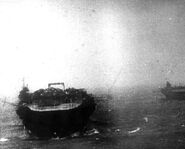Kaga (Japanese: 加賀) was Japan's first heavy carrier, she was laid down on 19 July 1920 at Kawasaki Heavy Industries shipyard as a Tosa class battleship. On 5 February 1922 both Tosa class ships were cancelled and designated for scrapping under the terms of the Washington Naval Treaty, but Kaga was therefore selected for completion as an aircraft carrier, instead of battlecruiser Amagi, damaged beyond repair in the earthquake in 1923. Conversion of Kaga was launched in 1925 and completed on 31 March 1928.[1]
Description[]
As completed, the ship had two hangar decks, the hangars opened onto two superimposed flying off decks at the bow. In theory, this permitted aircraft to take off directly from the hangars, while landing on the main flight deck above. In practice, the multiple flight deck arrangement proved unsuccessful. From 1934 to 1935, Kaga received a massive reconstruction at Yokosuka Naval Dockyard. There the hull was lengthened, the hangars extended forward, the flying off decks removed, the power and aircraft capacity increased and an island superstructure on the starboard side of the ship added.
History[]
She was active off China during the Sino-Japanese War, and was one of the main carriers that launched the planes that attacked Pearl Harbor, and after that, the invasion of Rabaul, the attack on Darwin, the Indian Ocean raids. She was lost at the Battle of Midway after being attacked by about thirty dive bombers. The first hit damaged the aft area of the flight deck, while the second crushed into the forward elevator, causing major damage below decks. By this point, Kaga had lost all her steering capabilities. Flight commander Takahisa Amagai was probably the luckiest of all senior officers at the bridge at that time, for that the next bomb probably landed close or squarely on it, and he was the only one who survived. The fourth and probably final hit landed amidships, but there was so much confusion that there could had been another.
The uncontrollable fire aboard Kaga could partly be attributed to Japanese carrier design of the time. According to plan, to fight fire in the enclosed hangar, the damage control team was to pull heavy fire curtains that were placed in the hangar designed to isolate. However, the fires occurring in multiple areas of the hangar made isolation impossible. Furthermore, a single water main running along the ship that supplied water for firefighting was destroyed when multiple bombs exploded near the lone water main. Finally, the hangar at the time was filled with ammunition; in this enclosed hangar, without an opening directly to the exterior, the crew simply had no way to move the heavy bombs and torpedoes away from the fires (only a few men remained alive in the hangar at this time, in any case). With aviation fuel continued flowing, there was no stopping of the conflagaration. Kaga's demise would have been just a bit quicker if American torpedoes were a bit more reliable: while Kaga was ablaze, USS Nautilus found the carrier and fired four torpedoes at her. The first was stuck in the tube, while the second and the third missed widely. The fourth hit Kaga squarely, scaring the swimming sailors near by, but it failed to detonate. Ironically, the torpedo broke in half and provided floatation tools for the Japanese sailors.
The crew of Kaga removed the Emperor's portrait at 1325 as it was determined that the carrier was now beyond repair, though gallant efforts to keep her alive continued for several more hours. By 1640, the order to abandon ship was finally given. At 1925, 4 June 1942, the escorting destroyer Hagikaze launched two torpedoes at the carrier after rescuing all the remaining survivors. A minute later, both 1,000-pound warheads hit Kaga's starboard side amidships. Commander Seiji Nakasugi stood on the deck of Hagikaze and witnessed his ship's last moment; "it was a horrendous sight to see a huge warship like this vanish. But she went nobly." At 1925, she went completely under the waves. Amagai lamented "I should have died with her".[2]
Part of Kaga's wreck was discovered in Sep 1999, at position 30°23' N 179°17' W. The wreckage, laying 17,000 feet below the surface, consists of two gun tubs and a section of the upper hanger deck, located on the starboard aft machine-gun gallery of Kaga.[3]


















